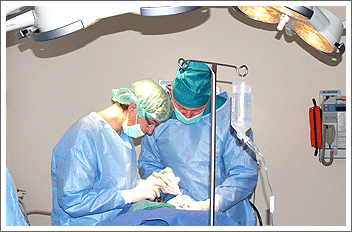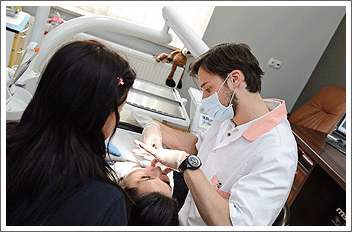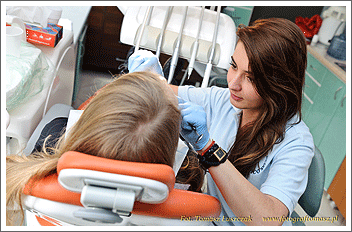


IMPLANTOLOGY
Mechanical injuries, caries and paradontium diseases are among the causes of tooth loss. Contemporary medicine offers much more durable solutions than popular bridges or dentures. A key to a beautiful smile is an implant that does not conceal a missing tooth but reconstructs a perfectly functioning natural-looking tooth.
An implant, like a tooth root, is an invisible element. It is made of titanium recognised by a human body as an integral part of it. It is practically impossible to tell a prosthetic crown attached to an implant from a natural tooth.
- embedding - an implant is embedded in the bone in a manner enabling the upper or lower jawbone to build up around it - the process is called osseointegration. It is particularly important that the process goes smoothly as it affects the stability and durability of new teeth. .
Prosthetic part:
- restoration in the form of a crown, bridge or denture after osseointegration is completed - the visible part of a tooth is attached to the implant post. This is the final stage of the procedure, restoring full functionality.
- single tooth missing
If a missing tooth is not restored, the surrounding bone gradually collapses and diminishes. Neighbouring teeth begin to move towards the gap due to lack of support. Their movement may lead to extensive dislocation of the remaining teeth. This prevents proper hygiene of teeth and gums and access to interproximal spaces. Moreover, it often leads to caries, sinking of alveolar process and loss of subsequent teeth. The actual complications resulting from a failure to restore a missing tooth depend on its location, age and general health condition of the patient.
- multiple teeth missing
If there are several teeth missing, the process generally follows the same pattern as described above; however, here the risk of deterioration of health is much higher. Jawbone starts to sink and recede. The alveolar process becomes thinner and reduces the possibility to replace missing teeth. The neighbouring teeth lose their support not only due to the missing teeth but also to the consequential bone receding.
- all teeth missing
The bone in which our teeth are rooted is continuously stimulated to rebuild by tooth roots, which ensure the retention of natural look of the jaws. Hence, when the roots are not there, the bone will gradually resorb. This, in turn, leads to changes in the face structure. The jaws shrink, the lips become thinner, and the wrinkles appear around the neck and lips.
Regular check-up visits at a dentist’s and proper oral hygiene is not enough. An implant is a solution that requires certain conditions to be met. One of them is sufficient bone volume necessary to hold implants or a good condition of the gums and of the parodontium. It is the role of the dentist to decide whether a patient is fit for dental implant treatment and what individual procedures are required.
Negative signals before starting the dental implant treatment:
Periodontitis
- in order for the treatment to be successful, any parodontium diseases must be cured before commencing the procedure.
Bruxism
- pathological attrition of teeth - the most common cause is the absence of molars, stress or eating sour (acidic) food. The treatment consists in eliminating the causes of stress, removing of the so called “protruding points” which helps in correcting the occlusion, and using special splints during sleep.
Reduced immunity
- here contraindications and their elimination depends on whether the person concerned suffers from an auto-immunological disease, takes steroids, or undergoes radiotherapy
Alcohol overuse and smoking
- overuse of alcohol and heavy smoking slows down and hinders the healing process.
In MEDICO, we pay special attention to precise determination of the bone quality, thickness and volume. We are one of the very few clinics in Poland and the only in our region to have the equipment enabling our implantology specialists to obtain a 3D picture of the patient’s jaws and its anatomic structures such as nerves and sinuses, the position and condition of which significantly affects the implantation process.
In the case of a one tooth missing, one implant holds one tooth crown. However, in the case of extensive teeth loss, embedding a single implant for each single missing tooth is unnecessary. Thanks to prosthetic bridges made in MEDICO, one implant can hold several crowns. However, the number of implants needed for teeth restoration depends on the volume and thickness of the bone tissue. If the whole teeth arch must to be reconstructed, at least two implants are needed in the lower jaw (mandible) and four in the upper jaw (maxilla). The situation differs from one patient to another, and our specialists will choose a solution that is best for you.
- a dentist takes impressions and makes a cast,
- the cast is scanned to produce a virtual image in the computer's memory (CAD),
- the digital design is sent to a digital cutting machine (CAM) via dedicated software, and the machine produces a single or complex construction, depending on whether a single tooth or a whole tooth arch is to be reconstructed,
- when the structure is ready, dental facing with ceramic dental veneers is performed.
Today, dental implant is an ordinary procedure. Yet, as it is the case with any surgery, complications may occur. The risk is minimised due to a number of specialist tests performed, such as tomographic imaging with the use of cone-beam CAT scanner that MEDICO has at its disposal. The information provided by a 3D image not only helps to decide on preparatory treatment, if necessary, but also to control the whole implant embedding procedure. The image shows the exact location of the nerves and sinuses, which - in the case of two-dimensional technologies - is never determined with a 100% confidence, thus posing the risk of damaging the nerve and causing paraesthesia.
HILOTHERAPIE®
It is a thermal-enabled therapy (in temperatures from 10° C to 30° C) eliminating swelling, pain and haematoma.
Although embedding of a single implant takes about an hour, the whole process is much longer. An implant inserted under local anaesthesia requires healing and osseointegration - the process during which an implant fuses into bone. In the case of upper jaw, it takes five to six months, in the case of lower jaw - three to four months. A titanium implant is then completely hidden under the gum. After the process of healing and osseintegration is completed, the prosthetic stage of the treatment begins, consisting in fixing a crown, bridge or denture. In the event of insufficient bone volume, additional procedures are needed, lengthening the whole treatment which may then last a dozen or so months. Every patient is different, therefore our specialists determine the anticipated duration of the whole treatment on an individual basis.
Inadequate oral care may cause gingivitis around the implant. If this condition is long-lasting, it may lead to loss of bone and uncovering of the implant. Taking care of your implants is extremely important and the principles to be followed are the same as in the case of natural teeth.
-Brushing - at least twice a day
-Flossing - in order to prevent accumulation of food deposits between teeth (the anaerobic decomposition of food causes, inter alia, bad breath).
-- Regular check-up visits at a dentist’s - twice a year
-Scaling - removal of the tartar
Naturally, the best teeth are your own natural teeth, provided that you care for them properly and correct all defects. An implant is a prosthetic solution replacing a missing tooth in the most natural way. If the dental implant procedure is correctly performed and a patient is committed to take proper care for the implants, they will last for a lifetime, quite often performing better than natural teeth.
Aesthetic look:
Implants permanently connected with the bone look and behave like natural teeth. What is more, quite often they look even better, because we can make the prosthetic reconstruction which make you teeth look perfect, which is not always the case with natural teeth.
Comfort and look
Due to permanent connection with the bone, implants eliminate the discomfort caused by removable dentures which, as suggested by the very term, do not stay in one fixed place. Implant insertion leads to total elimination of the need to remove dentures and to use prosthetic adhesives, and of other troublesome or embarrassing situations.
Healthy oral cavity
Unlike with prosthetic bridges, embedded implants do not require grinding of neighbouring teeth. They are not altered in any way, no interference into their natural structure is required, and a single implant offers better accessibility to interproximal spaces, thus enabling better hygiene and health of the oral cavity.
Easier eating
A removable denture hampers or sometimes even prevents biting. In the case of implants, the comfort of eating is comparable with having natural teeth. Implants eliminate problems with choosing food, eliminate pain and discomfort, and enable confident and painless biting and chewing.
Distinctive speech
Instability of a removable denture often causes indistinctive speech and lisping. Implants offer you the comfort of speaking freely and distinctively without concerns caused by a removable denture.
Durability of the replacement
Implants made of extremely durable titanium are solid and stable - the material fully integrates with natural tissues of human body. If properly cared for, they can last for a lifetime.
Improved self-confidence
It is guaranteed not only by comfort of use, but also by the aesthetic effect of the selected reconstruction. A beautiful smile will help you to regain the self-confidence you might have lost.
Smaller risk of bone loss.
After a tooth loss, bone tissue in its original site is no longer stimulated by its root to regenerate. The bone recedes, which may cause distortion of the jaw.
An implant inserted in the place of a missing tooth stimulates growth of the bone, thus preventing the loss of the valuable structure of alveolar process.
In the case of a denture, there is no way to save the bone. A denture adversely affects the bone. Changeable shape of the jaws requires denture adjustments or regular replacement with a new on, adapted to the alveolar process. Also worth mentioning is the aesthetic effect caused by bone loss, namely premature elderly look.
No unnecessary interference with nature
In the case of implants, there is no need to grind the neighbouring teeth. The construction of bridges secured on teeth may be damaged or completely destroyed as a result of weakening of one tooth, which may be a consequence of unnecessary grinding of a healthy tooth structure.
Perfect functionality
An implant undergoes the process of osseointegration - it grows into the bone, thus ensuring the comfort identical with natural teeth. Patients with traditional dentures often feel pain when eating hard foods. When biting into hard food, the exerted pressure is transferred onto the denture, which in turn, exerts pressure on the gums, often causing irritation or even gingivitis. A denture secured on implants is a much stable and comfortable solution.
Easier hygiene
Removable bridges and dentures require special care. In the case of implants, all that is needed is regular brushing and flossing and standard check-up visits at a dentist’s.
Aesthetic look
A removable denture, as suggested by the very name, is subject to movements. Loosening causes unnatural look. Many temporary prosthetic replacements have unaesthetic metal clasps which keep dentures or bridges in place. Not only are implants more comfortable, but they offer aesthetic effect that is at least comparable to natural teeth.
Surgical procedures
Sinus lift
Lifting of the sinus floor as preparation for dental implant treatment in patients with the sinus floor located too low to insert implants.
Jaw sinuses
These are two symmetrically located pneumatic cavities from the group of nasal sinuses. They are connected by nasal passages. Their floors are located above the upper jaw root apexes (most commonly reaching from 1st premolar to 2nd molar). However, the size and topography of jaw sinuses are individual anatomic features (therefore cone-beam tomographic imaging in order to avoid complications during or after surgery is needed).
Correct location of sinus floor
The best situation is when the bone tissue between the root apexes and the sinus floor is from several to a dozen or so millimetres thick. Sometimes root apexes (particularly of the 1st molar) are located within the sinus and are covered only with a thin lamella of bone and a mucus membrane with which the sinus is lined - this is a common and normal condition.
Sinking sinus floor
In the case of teeth loss, the bone of alveolar process is not stimulated and, as a result, recedes. The sinus floor is sinking and the bone is not thick enough to insert the implant, as the end of the implant would protrude into the sinus cavity.
Elevating sinus floor
In order to elevate the jaw sinus floor, a new bone must be produced in a controlled way through reducing the depth of the sinus. The augmentation process is used here
Bone grafting
It is a surgical procedure aimed at supplementing the missing bone with material holding the alveolar process to help the body in regenerating the missing bone. The grafted bone is reinforced by the newly grown tissue and fuses with it.
Indications::
Bone grafting and augmentation are used in the case of insufficient volume of bone tissue. The procedure is used most commonly in the case of bone loss:
- around tooth roots
- after tooth extraction,
- after mechanical injury
- as a result of long-lasting tooth absence
- after removal of a tumour or cyst
- before implant insertion.
The procedure::
- thorough cleaning of tooth-socket to remove altered or infected tissue
- placing grafting material in the tooth socket,
- placing a thin protective membrane over the affected area
- stitching the gum over the healing bone
The pain::
- grafting and augmentation procedures are performed under local anaesthesia and are painless
- mild pain and swelling may occur after the procedure, which can be treated with OTC painkillers
MEDICO offers state-of-the-art therapy with the use of HILOTHERAPY equipment.
HILOTHERAPIE®
It is a thermal-enabled therapy (in temperatures 10 oC to 30oC) eliminating swelling, pain and haematoma. It is used as preparatory treatment before a surgery, immediately after an injury, after surgical procedures as well as in chronic pain or inflammation conditions, in every part of the body. Pre-set temperature is retained for hours or even days of continuous operation. The use of HILOTERAPIE® immediately after a surgery does not completely eliminate pain, swelling or haematoma. However, the consumption of painkillers may be reduced to the minimum or, sometimes even avoided.
Postoperative care::
Like after any surgical procedure, special hygiene is required in the place operated on. Quite often, a dentist prescribes a specialist mouth wash and/or antibiotics in order to prevent infection. Special care is required while brushing or flossing the teeth (for the period of six weeks) and extensive pressure must be avoided until the bone has stabilised.
Augmentation
Augmentation is a guided bone regeneration process.
Special material (lyophilised osseous material, synthetic replacement material, or the patient’s own bone tissue obtained as a result of autogenic graft) is placed where the reconstruction is to be performed.
Due to natural regeneration processes of a human body, after a couple of months the grafted material transforms into a normal tissue (like in the case of bone regeneration after fracture). Indispensable in this procedure is a Piezosurgery device that MEDICO has at its disposal.
PiezoSurgery
is a unique device used for bone harvesting and sinus lifting. Unique inserts patented by metron allow for fast and very safe operation on the patient’s osseous system.
Lower alveolar nerve transposition
In special cases, when the bone cannot be reconstructed, an exceptional treatment method may be used, consisting in transposition of a nerve within the bone. This allows for using a larger amount of bone tissue and for embedding the implant of the required length.
Single tooth missing
The optimum aesthetic and functional effect will be achieved in this case with the use of implant with a ceramic crown. The treatment usually takes four visits.
Treatment stages:
- taking the patient’s medical history, performing necessary tests, taking an x-ray picture and performing cone-beam tomography (read more ...),
- anaesthesia, inserting the implant into bone, gum stitching until the osseointegration process is completed
- taking impressions, preparing the cast, scanning the cast and generating the virtual image in the computer’s memory (CAD), sending the digital design to the digital milling machine (CAM), cutting the structure, porcelain firing (read more ...)
Both visual and functional effect is comparable to the comfort of having natural teeth and, quite often, it is much more aesthetic than natural dentition. Every-day oral hygiene consists in regular visits at a dentist’s, flossing and brushing..

Multiple teeth missing
In the case of multiple teeth missing, the most cost-effective solution is a fixed bridge secured on dental implants.
In order to restore three or four missing teeth in the rear part of the oral cavity, a bridge secured on dental implants (serving as supporting structure) is used. It is the most stable and functional solution. It ensures comfort of chewing and does not limit in any way the choice of food. The bone is not exposed to any risk resulting from excessive pressure of the denture and the whole reconstruction looks aesthetic and allows for comfortable speaking.
Treatment stages:
- taking the patient’s history, performing tests - as in the case of one tooth missing;
- insertion of the implants - usually two at one visit - that will serve as a supporting structure for the bridge,
- the process of osseintegration lasting several months,
- making a bridge with the use of CAD/CAM technology. (Read more ...)
The final effect is the safest solution for the bones, offering comfort and hygiene of use. It ensures perfect functionality, ability to eat everything one wants and to speak distinctively. Undoubtedly, the procedure also produces the best aesthetic effect and resembles natural dentition.

All teeth missing
If all teeth are lost or need to be extracted, here again the best solution is a ceramic bridge secured on dental implants. This is the first permanent solution to total toothlessness, preventing destruction of bone tissue, receding gums and jaw shrinkage, which cause wrinkles and elderly look. Implants make not only the teeth, but the whole face look better.
The whole process varies from patient to patient, depending on individual features and needs. The dental implant treatment is usually performed in quarters (e.g. lower right-hand part) - one quarter per visit. Making a bridge for each quarter usually takes 4 to 5 visits.
Treatment stages:
- taking the patient’s dental history, performing standard tests as in the case of a single tooth missing;
- for the periods between inserting subsequent quarters, temporary denture can be made
- impressions are taken and a bridge is made with the use of CAD/CAM dental computer systems (Read more ...)
Persons who previously used removable dentures find this solution incomparable in terms of quality and comfort.
Aesthetic younger look, beautiful teeth, ability to eat any food, functionality and distinctive speech help to regain self-confidence.
































